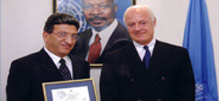Najib Saab, secretary-general of Arab Forum for Environment & Development, presented this keynote speech today 10 February, at the Future Force Conference, hosted this week in The Hague by the Dutch Minister of Defense and the Chief of the Armed Forces of the Netherlands.
Was the chaos in the Arab region instigated by the early impacts of climate change and the fight on dwindling life-support resources, or just aggravated by these factors? A proper analysis demands a comprehensive overview of the background.
A 2009 report by Arab Forum for Environment and Development found that Arab countries are among the most vulnerable in the world to the impacts of climate change. Those are mainly manifested in five areas: Water resources, sea-level rise, human health, food production, land use and urbanization.
Water resources are dwindling and Arab countries are already in the midst of a water crisis. Almost all of them are now below the level of severe water scarcity. Climate change will only worsen the situation, as water flow in the Euphrates may decrease by 30 percent, in the Jordan River by 80 percent and in the Nile by 50 percent before the turn of the century.
Sea-level rise is equally a big risk, since the bulk of the Arab region's economic activity and population centers are in the coastal zones that are highly vulnerable to sea-level rise. The AFED report revealed that a sea-level rise of 1 meter would directly impact 41,000 square kilometers of the Arab coastal land - the size of The Netherlands.
Human health would be adversely affected by higher temperatures, mainly due to changes in geographical ranges of disease vectors like mosquitoes, water quality and scarcity, air quality and food availability. Malaria, which already infects about 4 million people annually in the region, will enter new territories. Fiercer and more frequent sand storms will increase allergic reactions and pulmonary diseases.
Food production would face an increased threat, due to harsher and expanding aridity and changes in the spans of seasons, which will cut agricultural yields by up to half. The AFED 2014 report on food security already found alarming levels of food self-sufficiency in the Arab region, underscored by a 50 percent average deficit.
Land use and urban planning regulations in the Arab region largely ignore basic adaptation requirements to climate change. An estimated 75 percent of buildings and infrastructure are at direct risk of climate change impacts, mainly from sea level rise, higher intensity and frequency of hot days and storm surges. Reliability of transportation systems, water supply and waste-water networks, and energy generation stations will be at risk.
An AFED study on ecological footprint in the Arab countries found that available renewable natural resources per capita have fallen to less than half in just 50 years. Coupled with the growing impact of climate change and environmental deterioration due to inadequate resource management, this actually puts the region at the brink of an ecosystem bankruptcy.
Can those conditions act as potential conflict multipliers? Did the armed conflicts in Arab countries confirm what Thomas Homer-Dixon warned about in his 1999 book "Environment, Scarcity and Violence?" While the chaos of the past years in Arab countries showed that resource scarcity largely contributed to the escalation of conflicts, it was not the main cause that triggered them.
What brought people to the streets in the first place was the plight for human rights, mainly public participation in decision-making, accountability, transparency, and nondiscrimination. People were demanding good governance, implemented through political, social and economic systems, which secure fair distribution of wealth and benefits.
In the case of Syria, an extended severe drought, which started in 2007, drove millions of agricultural workers to urban areas in search of income. It is estimated that when the uprising started in 2011, about 60,000 Syrian families had been already displaced to suburbs of big cities due to drought. While Syria represented for two decades a rare case in the region achieving self-sufficiency in wheat production, the yields dropped by more than one-third in 2008. This was coupled by a large increase in prices of energy and an inflation of 152 percent. The displaced, largely discontented and unemployed people striving for sustenance, provided additional fuel to the uprising. Government attempts to ease the situation by introducing a series of economic measures were not successful, as street demands focused on political reforms.
At the beginning of the uprisings in some Arab countries, I published a report entitled "Arab Spring, Environment Autumn," followed by a study on the drought in Syria. While highlighting the interactive impact of resource scarcity, we found that, while it acted as a major multiplier, resource scarcity was not the main cause, which triggered the conflict.
However, the situation we are witnessing now, tragic as it is, would be no more than a preliminary rehearsal to what happens when the full-blown impacts of climate change knock on the door. The present numbers of the refugees and the displaced will be dwarfed by the influx of refugees due to climate change. The only viable recipe to avoid such a disaster is to treat causes at the source, by helping people acquire the means of dignified life in their original communities.
At the technical level, better resource efficiency can be achieved by adequate planning and sufficient finance. Proper management of the water-energy-food nexus can enhance efficiency and productivity and double food production in the Arab countries. Controlled urban expansion and regulations to make infrastructure and buildings resilient to climate change can reduce the impact of higher temperatures and rising sea level. A shift to green economy and renewable energy can help create jobs and diversify the economic base. This should be coupled with revamping the education system and supporting research and development.
All of this, however, won't be sustainable if countries do not foster the integration of human rights into the development agenda. This includes the principles of genuine public participation, accountability, transparency and nondiscrimination.
| 



